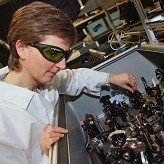A promising enzyme for green chemistry in Science

 An international consortium, including many researchers from CEA, CNRS, Inserm, École Polytechnique and the universities of Grenoble Alpes, Paris-Saclay and Aix-Marseille, as well as a Max Planck Institute in Germany and Stanford's Linear Accelerator Center (SLAC), have deciphered the working mechanisms of the FAP enzyme - for Fatty Acid Photodecarboxylase - naturally present in microscopic algae such as chlorella. This enzyme had been identified in 2017 to be able, with the help of light energy, of forming hydrocarbons from fatty acids produced by these microalgae. To achieve this new result published in Science on April 9, 2021, the research teams employed a complete experimental and theoretical panoply.
An international consortium, including many researchers from CEA, CNRS, Inserm, École Polytechnique and the universities of Grenoble Alpes, Paris-Saclay and Aix-Marseille, as well as a Max Planck Institute in Germany and Stanford's Linear Accelerator Center (SLAC), have deciphered the working mechanisms of the FAP enzyme - for Fatty Acid Photodecarboxylase - naturally present in microscopic algae such as chlorella. This enzyme had been identified in 2017 to be able, with the help of light energy, of forming hydrocarbons from fatty acids produced by these microalgae. To achieve this new result published in Science on April 9, 2021, the research teams employed a complete experimental and theoretical panoply.
Studying ultra-fast phenomena
Due to the fact that their reaction is triggered by light, photoenzymes give access to ultra-fast phenomena taking place during enzymatic reactions. The FAP enzyme therefore also represents a unique opportunity to understand in detail a chemical reaction taking place in living organisms.
More precisely, in this work, the researchers show that when the enzyme is illuminated and absorbs a photon, an electron is stripped off in 300 picoseconds (1 picosecond = one thousandth of a billionth of a second) from the fatty acid produced by the algae.
 Support l'X
Support l'X